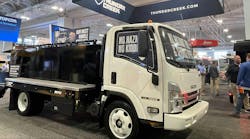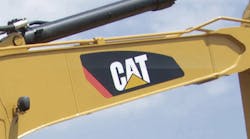As more and more equipment professionals are finding out, rubber-tracks on construction machines have a lot going for them. They travel across water-soaked ground that would bog down tires, extending the operating season. They work longer. And they get back to work sooner.
“Increased flotation and lower ground pressure allow machines to work on soft ground conditions, lengthening the season,” says Mike Fitzgerald, product representative, loader group at Bobcat.
Another major benefit: Rubber tracks minimize ground disturbance on finished surfaces, minimizing rework costs.
And because machines, such as rubber-tracked loaders, tend to weigh more than equipment on tires, says Fitzgerald, they produce more work in a given amount of time.
“If you're getting more jobs done, productivity increases,” he says. “That's a huge benefit.”
Not a ReplacementBut rubber tracks are not a replacement for tires. Rather, says Kent Pellegrini, marketing manager of Caterpillar's skid-steer and multi-terrain loader business, wheeled machines and rubber-tracked equipment complement each other on the jobsite.
“Use caution when comparing rubber-tracked equipment with wheeled machines,” he says. “They each have their own benefits. Rubber-tracked machines should be well thought out for applications where wheeled machines are traditionally used. Applications, such as demolition, excessively rocky conditions, and removal of highly abrasive materials, are not good applications for rubber tracks.”
Equipment managers who have a mixed fleet of machines on wheels and machines on rubber tracks should make sure the equipment is used for the job it's designed to do.
“If you are working in the dirt most of the time, use a track loader, and use equipment on tires when you're working on hard surfaces,” says Fitzgerald.
Maintaining Rubber TracksWith rubber tracks, the one maintenance practice that changes from those that equipment managers are more familiar with is that the undercarriage must be cleaned frequently.
“Cleaning is critical,” says Fitzgerald. “You have to clean the undercarriage to minimize wear on internal parts and prolong track life. If you don't clean the mud out, it will harden and cause premature wear on the inside surface of the track. It can also cause problems with tube lines and hoses.”
Ideally a pressure washer is used to remove chunks of mud. If there isn't a pressure washer on the jobsite, a small shovel or similar tool can be used.
Operators can also help extend the life of rubber tracks.
“The more care operators take when using rubber-tracked equipment, the longer the track will perform as expected,” says Diego Navarro, service marketing manager for John Deere Construction and Forestry.
Navarro suggests four guidelines for the proper maintenance of rubber-tracked machines:
Monitor track sag weekly or as needed. Certain soil conditions may require additional adjustments. Loose tracks can de-track; however, be careful not to over-tighten, which could cause power loss and excessive wear on undercarriage components.
Clean out the undercarriage, especially at the end of the work day in cold temperatures. This prevents material from freezing and putting excess loads on the operating system.
Minimize spinning of the tracks when possible. Unnecessary track spinning will accelerate wear. Train operators to make wide, less aggressive turns, especially on hard surfaces.
Use alternate turning directions. Continuous turning in the same direction can create an accelerated wear pattern on undercarriage components.
Other tips to extend rubber-track life, Navarro says, are:
Avoid constant operation across a slope or on the side of a hill. This will cause accelerated, uneven wear of undercarriage components. Unless the job requires otherwise, climb slopes straight up and down.
Don't travel with one track on a slope and the other on a flat surface.
Don't run over or along curbs and other structures, allowing tracks to rub against the structure.
Don't operate rubber-tracked machines on broken stone, jagged base, iron rods, scrap iron or other recycled materials.
Don't operate in corrosive material, such as fuel, oil, fertilizer, or salt. Clean the tracks and undercarriage with fresh water if these substances get on the tracks.
Avoid continuous transporting and aggressive turning on hard surfaces, such as asphalt or concrete.
Equipment professionals who want the benefits of rubber track, but have only wheeled vehicles might want to consider aftermarket rubber-tracks. These rubber tracks are installed around the machine's tires and can be removed when they aren't needed.
The life cycle of rubber tracks, says Bobcat's Fitzgerald, depends on the application and how the machine is handled by the operator.
“We've seen our tracks last 1200 to 1600 hours,” he says. “But we've also seen machines working on streets and asphalt that wore out in as little as 400 to 600 hours.”
Some Choices“All C-Series or Multi-Terrain loaders are available in one- or two-speed models,” says Pellegrini. “The two-speed option, with a top speed of 11.9 mph, can enhance productivity on the jobsite. It's new to the C-Series.”
Cat's new undercarriage has tapered roller bearings and heavy-duty metal face seals on idlers and bogies to help ensure long life.
“The open design of the undercarriage reduces material buildup during operation and minimizes the need for cleaning,” says Pellegrini. “When it does need cleaning, the design makes it easier to clean.
Module components can be replaced individually as needed.
“When the track needs to be replaced, the time required to do so is reduced significantly, compared to previous models,” says Pellegrini. “The open design of our new undercarriage means tracks are easy to clean with the tracks on the machine. If the tracks must be removed, the single level tracks can be taken off in less than 15 minutes. Dual level tracks can be removed in 15 minutes to an hour.”
Rubber-tracked undercarriages marketed by John Deere Construction and Forestry, says Navarro, achieve excellent balance, weight distribution and stability. They incorporate all the features of a full undercarriage that ensure durability and performance.
“Compact track loaders, for example, work well in applications where high traction, flotation and little disturbance to the soil are required,” says Navarro.
Gaining PopularityRubber-tracked machines are a growing segment of the compact equipment market.
“We see general contractors working in and around building sites, mall sites and on other rough surfaces with Bobcat rubber-tracked machines because they tend to bridge over the depressions and smooth out the bumps,” says Fitzgerald. “The machines work well for medium dirt guys who dig up or fill in basements, move dirt around houses and things like that. They use rubber tracks in conjunction with their other machines.”
And while rubber-tracked machines cost more to purchase and maintain, the benefits of flotation, extra performance, pushing power and the extended season make the investment well worth it.




